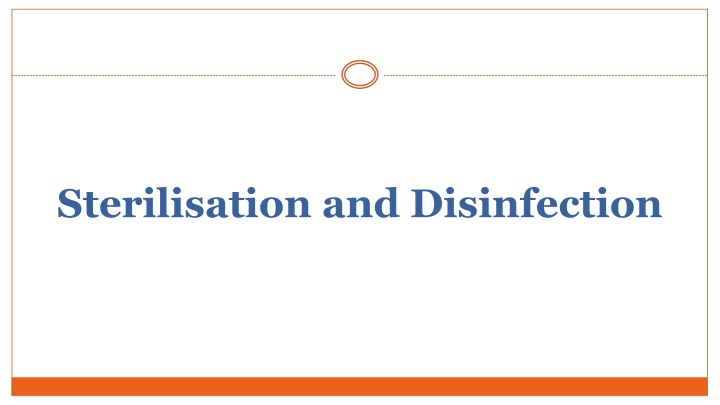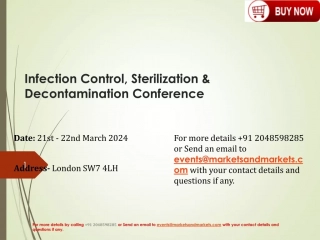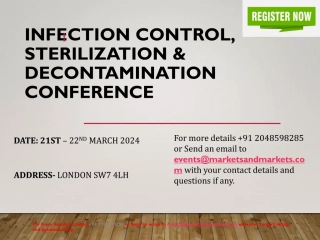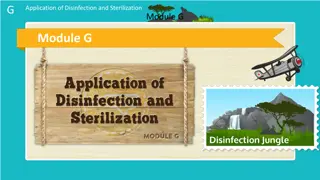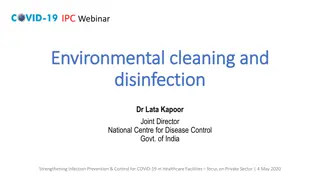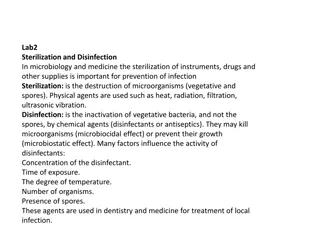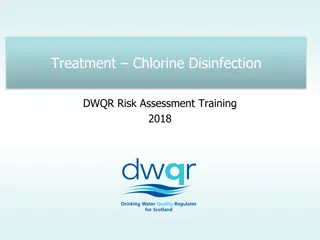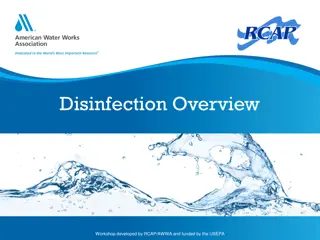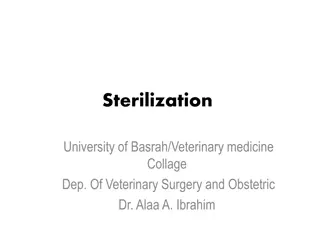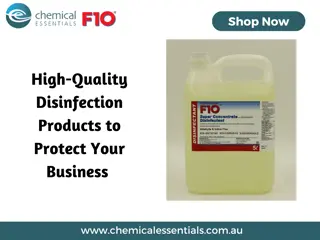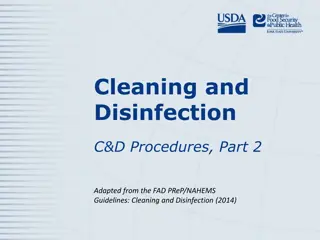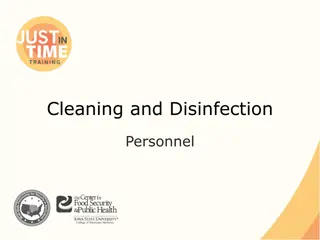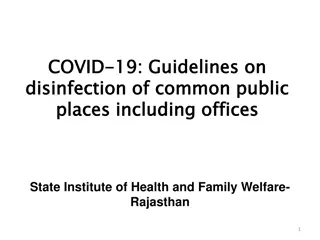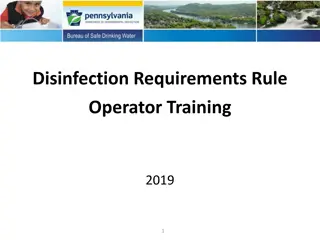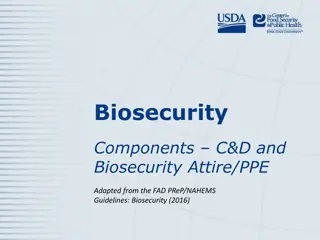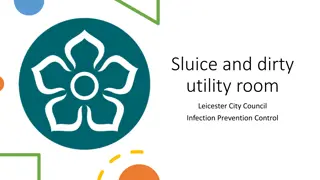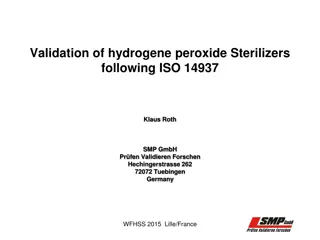Sterilisation and Disinfection
Mortality is high in HIV-infected individuals initiating antiretroviral therapy in sub-Saharan Africa due to infections like tuberculosis and fungal diseases. The REALITY trial in Kenya, Malawi, Uganda, and Zimbabwe investigates whether enhanced infection prophylaxis at ART initiation reduces mortality. The trial compares standard and enhanced prophylaxis in ART-naïve individuals with severe immunosuppression. An enhanced prophylaxis regimen includes medications targeting TB, fungal, bacterial, and protozoal infections, while the standard regimen mainly consists of cotrimoxazole. Follow-up includes safety monitoring and assessments up to week 48.
Download Presentation

Please find below an Image/Link to download the presentation.
The content on the website is provided AS IS for your information and personal use only. It may not be sold, licensed, or shared on other websites without obtaining consent from the author.If you encounter any issues during the download, it is possible that the publisher has removed the file from their server.
You are allowed to download the files provided on this website for personal or commercial use, subject to the condition that they are used lawfully. All files are the property of their respective owners.
The content on the website is provided AS IS for your information and personal use only. It may not be sold, licensed, or shared on other websites without obtaining consent from the author.
E N D
Presentation Transcript
Sterilisation Sterilisation is defined as the process where all the living microorganisms, either in the vegetative or spore state are killed. Sterilisation and disinfection are both decontamination process. The process of sterilisation is used in microbiology to prevent contamination by extraneous organisms, in surgery to maintain asepsis, in food and drug manufacture to ensure safety from contaminating organisms. Chemicals are used to destroy all forms of microbiologic life, they can be called chemical sterilants.
Disinfection Disinfection is the process of elimination of most pathogenic microorganisms (excluding bacterial spores) on inanimate objects. Different disinfectants have different target ranges, not all disinfectants can kill all microorganisms. Some methods of disinfection such as filtration do not kill bacteria, they separate them out. Decontamination is the process of removal of contaminating pathogenic microorganisms from the articles by a process of sterilisation or disinfection. It is the use of physical or chemical means to remove, inactivate or destroy living organisms on a surface so that the organisms are no longer infectious.
Sanitisation is the process of chemical or mechanical cleansing, applicable in public health systems. Usually used by the food industry. It reduces microbes on eating utensils to safe, acceptable levels for public health. Asepsis is the employment of techniques such as usage of gloves, air filters, uv rays etc to achieve microbe free environment. Antisepsis is the use of chemicals (antiseptics) to make skin or mucus membranes devoid of pathogenic microorganisms. Bactericidal is that chemical that can kill or inactivate bacteria. Such chemicals may be called variously depending on the spectrum of activity, such as bactericidal, virucidal, fungicidal, microbicidal, Sporicidal, tuberculocidal or germicidal.
Methods of Sterilisation 1.Physical Sunlight Heat. Dry heat Red heat Flaming Incineration Hot air oven Moist heat Below 100 (Pasteurisation) At 100 (Boiling,Tyndallisation) Above 100 (Autoclave) Drying Filtration Radiation Non-ionising Ionising
2.Chemical Liquid Alcohols Aldehydes Dyes Phenols Halogens Surface-active agents Metallic salts Gaseous Ethylene oxide Formaldehyde
PHYSICAL METHODS OF STERILISATION: Sunlight: 1. The microbicidal activity of sunlight is mainly due to the presence of ultra violet rays in it. 2. It is responsible for spontaneous sterilisation in natural conditions. 3. In tropical countries, the sunlight is more effective in killing germs due to ultraviolet rays and heat.
Heat Heat is the most reliable method of sterilisation of materials that can withstand heat and those materials that may be damaged by heat can be sterilised at lower temperatures , for longer periods or by repeated cycles. Mechanism of action : The killing effect of dry heat is due to protein denaturation, oxidative damage and the toxic effect of elevated levels of electrolytes.
The lethal effect of moist heat is due to the denaturation and coagulation of protein. Most heat is superior to dry heat in action. Temperature and time are inversely proportional .As temperature increases the time taken decreases. Thermal death time is the minimum time required to kill a suspension of organisms at a predetermined temperature in a specified environment. Articles that are heavily contaminated require higher temperature or prolonged exposure. Organic materials such as protein, sugars, oils, and fats increase the time required.
Dry Heat: Red heat: Articles such as bacteriological loops, straight wires, tips of forceps are sterilised by holding them in Bunsen flame till they become red hot. Flaming: This is a method of passing the article over a Bunsen flame, but not heating it to redness. Articles such as scalpels, mouth of test tubes, flasks, glass slides and cover slips are passed through the flame a few times.
Incineration: This is an excellent method for safely destroying contaminated materials such as contaminated cloth, animal carcasses and pathological materials by burning them in incinerator. Plastics such as PVC and polythene can be dealt with similarly but polystyrene materials emit clouds of dense black smoke and hence should be autoclaved in appropriate containers.
Hot air oven: This method was introduced by Louis Pasteur. Articles to be sterilised are exposed to high temperature (160 ) for duration of one hour in an electrically heated oven.Since air is poor conductor of heat even distribution of heat throughout the chamber is achieved by a fan. The heat is transferred to the article by radiation, conduction and convection. Articles to be sterilised must be perfectly dry before placing them inside to avoid breakage. The material should be arranged so as to allow free circulation of air between the objects.
Mouths of flasks, test tubes and both ends of pipettes must be plugged with cotton wool. Articals such as petri dishes and pipettes may be arranged inside metal canisters and then placed. Individual glass articles must be wrapped in Kraft paper or aluminium foils. Metallic instruments (like forceps, scalpels, scissors), glasswares(such as petri-dishes, pipettes,flasks,all glass syringes),swabs,oils, grease, petroleum jelly and some pharmaceutical products can be sterilised in hot air oven.
Moist Heat:At temperature below 100 Pasteurisation: This process originally employed by Louis Pasteur. There are two methods of pasteurisation, the holder method(heated at 63 for 30 minutes) and flash method(heated at 72 for 15-20 seconds) followed by quickly cooling to 13 or lower. This method is suitable to destroy most milk borne pathogens like Salmonella, Mycobacteria, Streptococci, Staphylococci and Brucella. Vaccine bath:The contaminating bacteria in a vaccine preparation can be inactivated by heating in a water bath at 60 for one hour. Only vegetative bacteria are killed and spores survive.
Serum bath: The contaminating bacteria in a serum preparation can be inactivated by heating in a water bath at 56 for one hour on several successive days.Proteins in the serum will coagulate at higher temperature. Inspissation:This is a technique to solidify as well as disinfect egg and serum containing media.The medium containing serum or egg are placed in the slopes of an inspissator and heated at 80-85 for 30 minutes on three successive days. Temperature at 100 : Boiling:Boiling water( (100 ) kills most vegetative bacteria and viruses immediately, but sporing bacteria require prolonged periods of boiling. Some bacterial spores are resistant to boiling and survive; hence this is not a substitute for sterilisation. Certain bacterial toxins such as Staphylococcal enterotoxin are also heat resistant. The killing activity can be enhanced by addition of 2% sodium bicarbonate. When absolute sterility is not required, certain metal articles and glasswares can be disinfected by placing them in boiling water for 10-20 minutes.The lid of the boiler must not be opened during the period.
Steam at atmospheric pressure (100 ): Instead of keeping the articles in boiling water, they are subjected to free steam at 100 .Traditionally Arnold s and Koch s steamers were used. A steamer is a metal cabinet with perforated trays to hold the articles and a conical lid.The bottom of steamer is filled with water and heated.The steam that is generated sterilises the articles when exposed for a period of 90 minutes. Media such as TCBS, DCA and selenite broth are sterilised by steaming.Sugar and gelatin in medium may get decomposed on autoclaving,hence they are exposed to free steaming for 20 minutes for three successive days.This process is known as tyndallisation (after John Tyndall) or intermittent sterilisation.
At temperature above 100 : Autoclave:- Sterilisation can be achieved at a temperature above 100 using an autoclave. Water boils at 100 at atmospheric pressure, but if pressure is raised, the temperature at which the water boils also increases.ln an autoclave the water is boiled in a closed chamber.As the pressure rises, the boiling point of water also raises. At a pressure of 15 lbs inside the autoclave, the temperature is said to be 121 . Exposure of articles to this temperature for 15 minutes sterilises them. To destroy the infective agents associated with spongiform encephalopathy (prions) 135 or 121 for at least one hour are recommended.
Steam has more penetrative power than dry air, it moistens the spores (moisture is essential for coagulation of proteins. Articles sterilised: Culture media, dressings, certain equipment etc.
Drying Moisture is essential for the growth of bacteria. Four-fifths of the weight of the bacterial cell is due to water. Drying in air has, therefore, a deleterious effect on many bacteria. However, this method is unreliable. Spores are unaffected by drying.
Filtration Filtration does not kill microbes, it separates them out. Membrane filters with pore sizes between 0.2-0.45 micrometer are commonly used to remove particals from solutions that cannot be autoclaved. It is used to remove microbes from heat labile liquids such as serum, antibiotic solutions, sugar solutions, urea solutions. The older filters made of earthenware or asbestos are called depth filters.
Radiation Two types of radiation are used, ionising and non-ionising. Non-ionising rays are low energy rays with poor penetrative power while ionising rays are high-energy rays with good penetrative power. Since radiation does not generate heat, it is termed cold sterilisation. Non-ionising rays: Rays of wavelength longer than the visible light are non-ionising. Microbicidal wavelength of UV rays lie in the range of 200-280,with 260 nm being most effective.
UV rays are generated using a high pressure mercury vapor lamp. Microorganisms such as bacteria, viruses,yeast etc.that are exposed to the effective UV radiation are inactivated within seconds. Since UV rays don't kill spores,they are considered to be of use in surface disinfection. UV rays are employed to disinfect hospital wards, operation theatres,virus laboratories, corridors etc. Ionising radiation:X-rays, gamma rays and cosmic rays are highly lethal to DNA and other vital constituents. They have very high penetrative power. Since there is no appreciable increase in temperature in this method, it is referred to as cold sterilisation.
Commercial plants use gamma radiation for sterilising items like plastics, syringes, swabs, catheters, animal feeds, cardboard, oils, fabric and metal foils.
CHEMICAL METHOD OF DISINFECTION Disinfectants are those chemicals that destroy pathogenic bacteria from inanimate surfaces. Some chemical have very narrow spectrum of activity and some have very wide. Those chemicals that can sterilise are called chemisterilants. Those chemicals that can safely applied over skin and mucus membranes are called antiseptics.
Classification of disinfectants: 2.Chemical Liquid Alcohols Aldehydes Dyes Phenols Halogens Surface-active agents Metallic salts Gaseous Ethylene oxide Formaldehyde
Spectrum of activity Vegetativ e cells Mycobacter ia Spor es Fungi Viruse s Examples Ethylene oxide, Gluteraldehyde, Formaldehyde High level + + + + + Phenol, Halogens Intermediat e level + + - + + Alcohols Low level + - - + +/-
Properties required for chemical agents: Should have a wide spectrum of activity and be effective against all microorganisms. Should be effective in the presence of organic matter. Should be effective in acid as well as alkaline media. Should have speedy action. Should have penetrating power. Should be stable. Should not corrode metals. Should not cause local irritation or sensitisation. Should not interfere with healing. Should not toxic if absorbed into circulation.
Alcohols: Alcohols dehydrate cells, disrupt membranes and cause coagulation of protein. A 70% aqueous solution is more effective at killing microbes than absolute alcohols. 70% ethyl alcohol (spirit) is used as antiseptic on skin. Isopropyl alcohol is preferred to ethanol.It can also be used to disinfect surfaces. It is used to disinfect clinical thermometers. Methyl alcohol kills fungal spores, hence is useful in disinfecting inoculation hoods. Examples: Ethyl alcohol, isopropyl alcohol and methyl alcohol. Disadvantages: Skin irritant, volatile (evaporates rapidly), inflammable.
Aldehydes: Acts through alkylation of amino, carboxyl or hydroxyl group and probably damages nucleic acids. It kills all microorganisms including spores. 40% fomaldehyde or formalin is used for surface disinfection and fumigation of rooms, chambers, operation theatres, biological safety cabinets, wards, sick rooms etc. Fumigation is achieved by boiling formalin, heating paraformaldehyde or treating formalin with potassium permanganate. 2% gluteraldehyde is used to sterilise thermometers, cystoscopes, centrifuges, anasethetic equipments etc. Examples: Formaldehyde, Gluteraldehyde. Disadvantages: Vapors are irritating (must be neutralized by ammonia), has poor penetration.
Phenol: Act by disruption of membranes, precipitation of proteins and inactivation of enzymes. Phenols are coal tar derivatives, they act as disinfectants at high concentration and as antiseptics at low concentrations. They are bactericidal, fungicidal, mycobactericidal but are inactive against spores and most viruses. The corrosive phenolics are used for disinfection of ward floors, in discarding jars in laboratories and disinfection of bedpans. Chlorhexidine can be used in an isopropanol solution for skin disinfection, or as an aqueous solution for wound irrigation. Examples: 5% phenol,1-5% Cresol, 5% Lysol, Chlorhexidine, Chloroxylenol (Dettol), Hexachlorophene. Disadvantages: It is toxic, corrosive and skin irritant.
Halogens: They are oxidizing agents and cause damage by oxidation of essential sulfydryl groups of enzymes. Chlorine reacts with water to form hypochlorus acid, which is microbicidal. Tincture of iodine (2% iodine in 70% alcohol) is an antiseptic. Iodine can be combined with neutral carrier polymers such as polyvinylpyrrolidone to prepare iodophores such as povidone-iodine. 10% Povidone iodine is used undiluted in pre and post operative skin disinfection. 0.5% sodium hypochlorite is used in serology and virology. Used at a dillution of 1:10 in decontamination of spillage of infectious materials. Examples: Chlorine, bleach, hypochlorite, tincture iodine etc. Disadvantages: Rapidly inactivated in the presence of organic matter. Iodine is corrosive and staining.
Heavy metals: Act by precipitation of proteins and oxidation of sulfydryl groups. They are bacteriostatic. 1% silver nitrate solution can be applied on eyes as treatment for opthalmia neonatorum. Silver sulphadiazine is used topically to help to prevent colonization and infection of burn tissues. Copper salts are used as a fungicide. Examples: Mercuric chloride, silver nitrate, copper sulfate etc. Disadvantages: Mercuric chloride is highly toxic.
Surface active agents: They are active against vegetative cells, mycobacteria and enveloped viruses. They are widely used as disinfectants at dilution of 1-2% for domestic use and hospitals. They have the property of concentratig at interfaces between lipid containing membrane of bacterial cell and surrounding aqueous medium. These compounds have long chain hydrocarbons that are fat soluble and charged ions that are water soluble. Since they contain both of these, they concentrate on the surface of membranes. They disrupt membrane resulting in leakage of cell constituents. Examples: These are soaps and detergents. Disadvantages: Their activity is reduced by hard water, anionic detergents and organic matter.
Dyes: Acredine dyes are bactericidal because of their interaction with bacterial nucleic acids. They may be used topically as antiseptics to treat mild burns. They are used as paint on skin to treat bacterial skin infections. The dyes are used as selective agents in certain selective media. Examples:Aniline dyes such as crystal violet, malachite green and brillient green, acridine dyes etc.
Hydrogen peroxide : It acts on the microorganisms through its release of nascent oxygen. Hydrogen peroxide produces hydroxyl free radical that damages proteins and DNA. It is used 6% concentration to decontaminate the instruments, equipments such as ventilators. 3% hydrogen peroxide solution is used for skin disinfection and deodorising wounds and ulcers. Strong solutions are sporicidal. Disadvantage: Decomposes in light, broken down by catalase, proteinaceous organic matter drastically reduces its activity.
Ethylene oxide: It is an alkylating agent. It acts by alkylating sulfydryl, amino, carboxyl, and hydroxyl groups. It is a highly effective chemisterilent, capable of killing spores rapidly. Since it is highly flammable, it is usually combined with carbon di oxide (10% CO2 +90% EO) or dichlorodifluoromethane. It is used to sterilise heat labile articles such as bedding, textiles, rubber, plastics, syringes, disposable petri dishes, heart lung machine, respiratory and dental equipments. Disadvantages: It is highly toxic,irritating to eyes, skin, highly flammable, mutagenic and carcinogenic.
References Textbook of Medical Microbiology by Ananthnarayan and Paniker Textbook of Medical Microbiology by D.R. Arora
